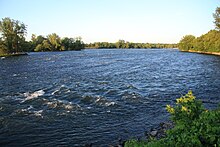Moxostoma hubbsi
| Moxostoma hubbsi | ||||||||||||
|---|---|---|---|---|---|---|---|---|---|---|---|---|
| Systematics | ||||||||||||
|
||||||||||||
| Scientific name | ||||||||||||
| Moxostoma hubbsi | ||||||||||||
| ( Legendre , 1942) |
Moxostoma hubbsi , engl. Copper Redhorse, French Chevalier Cuivré, is aspecies ofsucker carp of the genus Moxostoma thatoccursonly in Canada . It is the only endemic species of fish in the province of Québec .
It is believed that the species was first described in 1866 by Pierre Étienne Fortin under the name of another Moxostoma species, officially the species was discovered and first described in 1942 by Vianney Legendre .
features
Moxostoma hubbsi is a stocky, high-backed suction carp that usually reaches a body length of 47.5 centimeters TL . The largest specimen caught so far was 72 centimeters long and weighed 6 kilograms. The head makes up about 20% of the body length of animals over 25 cm standard length. Moxostoma hubbsi is gold-olive colored, often shiny copper-colored on the upper side of the body. The scales have a dark spot on their back and sides. The mouth can be turned out. Its lips are wrinkled, the lower lip is slightly V-shaped at the rear end. The fins are yellow to red. The large caudal fin is forked with pointed fin lobes.
The number of scales on the sideline is usually 44 to 47, the dorsal fin has 12 to 13 rays .
distribution and habitat
Moxostoma hubbsi occurs only in a very small area. The historical distribution area was limited to southwest Québec, from the western tip of the Île de Montréal (island of Montreal) to the eastern Lac Saint-Pierre . Secure populations are currently only found in the St. Lawrence River and in the Rivière Richelieu (Richelieu River). A remaining population is likely to be in the Rivière des Mille Îles (“River of a Thousand Islands”). In the Rivière Yamaska and Rivière Noire , their stocks have declined sharply due to environmental degradation. The occurrence there is not certain and very unlikely. The distribution area of Moxostoma hubbsi is in the most densely populated region of Québec.
These carp live mainly in medium-sized rivers, the temperature of which exceeds 20 ° C in summer. Most of them are in stone-bottomed pools, backwater or rapids with a slight gradient.
Way of life
Moxostoma hubbsi feeds exclusively on small mollusks . More than 90% of the prey animals in the digestive tract of adults have been identified as snails and mussels. Young fish that are less than a year old feed more than 50% on tiny crustaceans (microcrustaceans) as well as worms, algae and insect larvae.
Moxostoma hubbsi reaches sexual maturity late, around the age of 10. It spawns in late June to early July when water temperatures are between 18 and 26 ° C. Well-known spawning sites are found in white water at depths of 0.75 to two meters and a heterogeneous bottom made of rock, fine and coarse gravel and occasionally fragments of rock soil embedded in clay. Spawning usually takes place at night; the number of eggs varies from 35,000 to 112,000. The fry spend their first year in the grassy bank region over a fine soil substrate. The catch of juvenile fish is rare, so it is not known in which habitat they are after two years.
Endangerment status
Due to their high specialization in environmental conditions, the population is severely threatened. The population began to decline in the 1980s. The reproduction and growth rate of Moxostoma hubbsi are very low. A sharp decrease in the size distribution has also been observed over the past 30 to 40 years. Hardly any fish older than two years are caught. The total number of sexually mature fish is only a few hundred to a few thousand specimens. Other threatening factors are habitat fragmentation and degradation , water silting, eutrophication , pollution, water engineering measures, disturbances during the spawning process and the introduction of invasive species .
The IUCN (International Union for Conservation of Nature and Natural Resources) classifies the species as Endangered (EN).
literature
- C. Lippé, P. Dumont and L. Bernatchez: High genetic diversity and no inbreeding in the endangered copper redhorse, Moxostoma hubbsi (Catostomidae, Pisces): the positive sides of a long generation time, Mol Ecol. 2006 Jun; 15 (7): 1769-80. PMID 16689897
- Yves de Lafontainea, Nicolas L. Gilberta, François Dumouchela, Charles Brochub, Serge Mooreb, Émilien Pelletierc, Pierre Dumontd, Alain Branchaude: Is chemical contamination responsible for the decline of the copper redhorse (Moxostoma hubbsi), an endangered fish species, in Canada ? . In: Science of the Total Environment , Volume 298, Issues 1-3, 21 October 2002, Pages 25-44, doi : 10.1016 / S0048-9697 (02) 00166-3 .
- Moxostoma hubbsi inthe IUCN Red List of Threatened Species 2014.4. Listed by: Gimenez Dixon, M., 1996. Retrieved May 15, 2015 ..
Notes and individual references
- ↑ Translated literally "Copper Moxostoma ", the genus Moxostoma is in English. Called Redhorse
- ↑ trans. Literally "copper-colored Chevalier," as Chevalier are in French. Species of fish, including the genus Moxostoma referred
- ↑ a b c d e f Species at Risk Act Recovery Strategy Series. Fisheries and Oceans Canada, Ottawa: Recovery Strategy for the Copper Redhorse (Moxostoma hubbsi) in Canada. 2012, ISBN 978-1-100-20792-6 , xi + 60 pp. ( Online )
- ↑ a b Moxostoma hubbsi on Fishbase.org (English)
- ^ Fishing World Records: Moxostoma hubbsi
- ^ A b c Lawrence M. Page, Brooks M. Burr: Peterson Field Guide to Freshwater Fishes of North America North of Mexico. Houghton Mifflin Harcourt, 2011, ISBN 978-0547242064 , p. 183.
- ↑ a b c d e f g h Moxostoma hubbsi in the Red List of Threatened Species of the IUCN .
- ↑ a b Canadian Science Advisory Secretariat: Recovery Potential Assessment Report of Copper Redhorse (Moxostoma hubbsi) 2008. ( Online , PDF; 145 kB)
